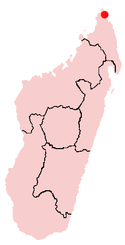Antsiranana
| Antsiranana | |
|---|---|
|
Antsiranana | |
 Antsiranana Location of Antsiranana in Madagascar | |
| Coordinates: 12°18′S 49°17′E / 12.300°S 49.283°E | |
| Country |
|
| Region | Diana Region |
| Area | |
| • Total | 42 km2 (16 sq mi) |
| Population (2013) | |
| • Total | 115,015 |
| • Density | 2,700/km2 (7,100/sq mi) |
| Climate | Aw |

Antsiranana (Malagasy: Antsiran̈ana Malagasy pronunciation: [antsʲˈraŋanə̥]), named Diego-Suarez prior to 1975, is a city in the far north of Madagascar.
Antsiranana is the capital of Diana Region. It had an estimated population of 115,015 in 2013.[1]
Transport

Antsiranana is situated on Antsiranana Bay, one of the largest deepwater harbors in the Indian Ocean, but the remote location, and, until recently, a bad road to the south, rendered it unimportant for freight traffic. Arrachart Airport provides communication primarily with other parts of Madagascar.
Climate
| Climate data for Antsiranana (1961–1990, extremes 1941–present) | |||||||||||||
|---|---|---|---|---|---|---|---|---|---|---|---|---|---|
| Month | Jan | Feb | Mar | Apr | May | Jun | Jul | Aug | Sep | Oct | Nov | Dec | Year |
| Record high °C (°F) | 36.3 (97.3) |
34.6 (94.3) |
34.8 (94.6) |
35.0 (95) |
33.6 (92.5) |
33.0 (91.4) |
32.0 (89.6) |
33.0 (91.4) |
33.0 (91.4) |
37.0 (98.6) |
38.0 (100.4) |
39.0 (102.2) |
39.0 (102.2) |
| Average high °C (°F) | 30.2 (86.4) |
30.2 (86.4) |
30.6 (87.1) |
31.0 (87.8) |
30.4 (86.7) |
29.3 (84.7) |
28.7 (83.7) |
28.7 (83.7) |
29.5 (85.1) |
30.5 (86.9) |
31.5 (88.7) |
31.4 (88.5) |
30.2 (86.4) |
| Daily mean °C (°F) | 26.0 (78.8) |
26.0 (78.8) |
26.2 (79.2) |
26.3 (79.3) |
25.4 (77.7) |
24.1 (75.4) |
23.5 (74.3) |
23.4 (74.1) |
24.1 (75.4) |
25.2 (77.4) |
26.3 (79.3) |
26.5 (79.7) |
25.2 (77.4) |
| Average low °C (°F) | 22.8 (73) |
22.7 (72.9) |
22.9 (73.2) |
22.6 (72.7) |
21.6 (70.9) |
20.2 (68.4) |
19.6 (67.3) |
19.4 (66.9) |
20.0 (68) |
21.2 (70.2) |
22.5 (72.5) |
22.9 (73.2) |
21.5 (70.7) |
| Record low °C (°F) | 17.0 (62.6) |
16.6 (61.9) |
14.0 (57.2) |
17.8 (64) |
16.2 (61.2) |
13.5 (56.3) |
13.8 (56.8) |
13.0 (55.4) |
14.7 (58.5) |
16.3 (61.3) |
18.2 (64.8) |
18.7 (65.7) |
13.0 (55.4) |
| Average rainfall mm (inches) | 337.5 (13.287) |
305.8 (12.039) |
179.4 (7.063) |
52.3 (2.059) |
13.4 (0.528) |
19.1 (0.752) |
19.0 (0.748) |
18.7 (0.736) |
8.8 (0.346) |
17.4 (0.685) |
54.6 (2.15) |
170.8 (6.724) |
1,196.8 (47.118) |
| Average precipitation days (≥ 1.0 mm) | 16 | 15 | 12 | 6 | 4 | 3 | 4 | 4 | 2 | 3 | 5 | 10 | 84 |
| Average relative humidity (%) | 79 | 92 | 81 | 76 | 70 | 68 | 66 | 66 | 66 | 65 | 71 | 76 | 72 |
| Mean monthly sunshine hours | 189.2 | 170.0 | 214.9 | 256.4 | 284.8 | 256.5 | 273.1 | 283.6 | 293.3 | 306.8 | 281.5 | 228.9 | 3,039 |
| Source #1: NOAA[2] | |||||||||||||
| Source #2: Deutscher Wetterdienst (humidity, 1951–1967),[3] Meteo Climat (record highs and lows)[4] | |||||||||||||
History
The bay and city originally used the name Diego Suarez, named after Diogo Soares, a Portuguese navigator who visited the bay in 1543.[5]
In the 1880s, the bay was coveted by France, which desired it as a coaling station for steamships. After the first Franco-Hova War, Queen Ranavalona III signed a treaty on December 17, 1885 granting France a protectorate over the bay and surrounding territory, as well as the islands of Nosy-Be and Ste. Marie de Madagascar.
The colony's administration was subsumed into that of Madagascar in 1896. The Second Pacific Squadron of Imperial Russia anchored and was resupplied at Diego-Suarez on its way to the Battle of Tsushima in 1905.

In 1942, Diego Suárez was the primary objective of Operation Ironclad, the starting point of the Allied invasion and capture of Madagascar. The Allies were concerned that Japan would pressure Vichy France into granting use of Madagascar, as they had with French Indo-China during the previous year, and determined that the island should not be made a base for the interdiction of Allied shipping. Diego Suarez, with its superlative harbor and a concentration of government officials, was selected as the initial invasion point. The Japanese responded with an attack by midget submarines on the British naval forces in the harbor, damaging Battleship HMS Ramillies and sinking an oil tanker.
France continued to use the city as a military base after Malagasy independence in 1960 and until the socialist revolution of 1973.
Education
Lycée Français Diego Suarez, or Lycée Français Sadi-Carnot, is a French international school in Antsiranana. Historically it was the Collège français Sadi Carnot.[6][7]
Postage stamps
In popular culture
The climactic scenes of the alternative history novel The Madagaskar Plan are set in the city.
See also
References
- ↑ Institut National de la Statistique, Antananarivo.
- ↑ "Diego–Suarez/Antsir (Antsiranana) Climate Normals 1961–1990". National Oceanic and Atmospheric Administration. Retrieved October 19, 2015.
- ↑ "Klimatafel von Antsiranana (Diégo-Suarez) / Madagaskar" (PDF). Baseline climate means (1961-1990) from stations all over the world (in German). Deutscher Wetterdienst. Retrieved 10 June 2016.
- ↑ "Station Antsiranana" (in French). Meteo Climat. Retrieved 10 June 2016.
- ↑ Pierre Van Den Boogaerde, Shipwrecks of Madagascar, p.40
- ↑ "Accueil." Lycée Français Diego Suarez. Retrieved on 7 May 2015.
- ↑ "Lycée français Sadi-Carnot." AEFE. Retrieved on May 7, 2015.
External links
 Media related to Antsiranana at Wikimedia Commons
Media related to Antsiranana at Wikimedia Commons
Coordinates: 12°18′S 49°17′E / 12.300°S 49.283°E

